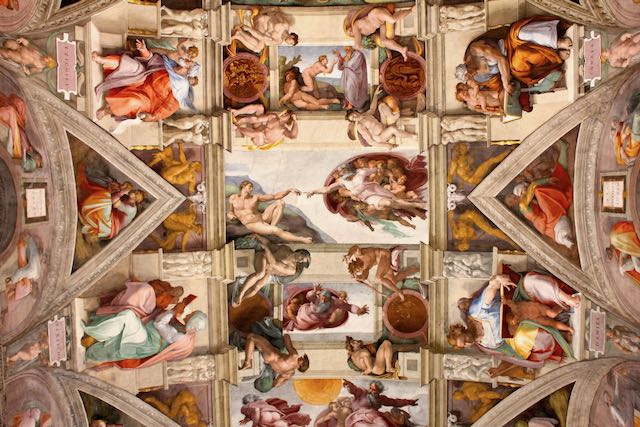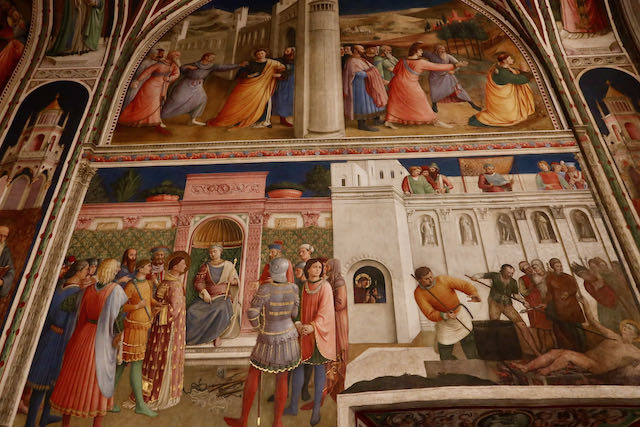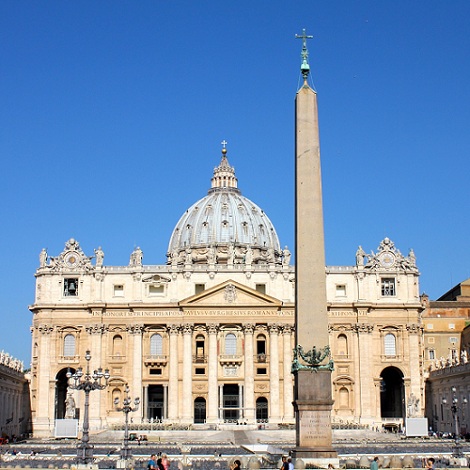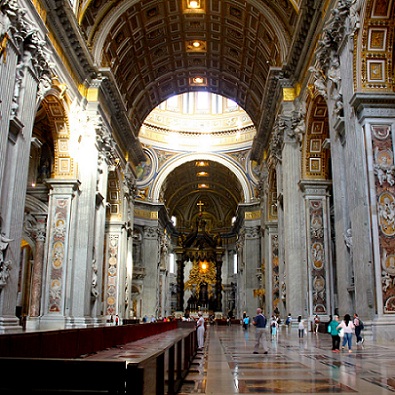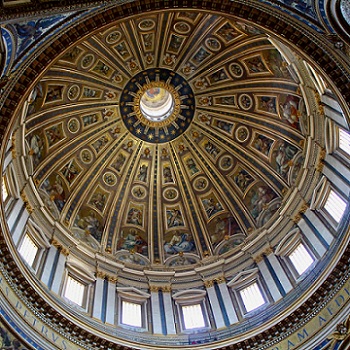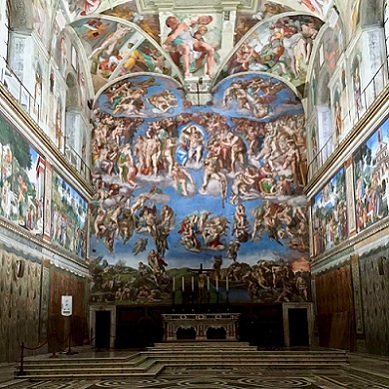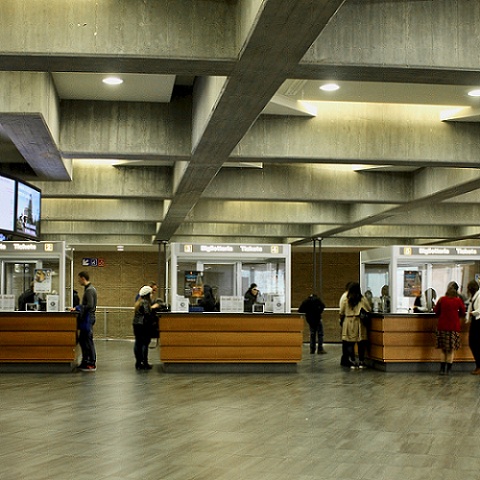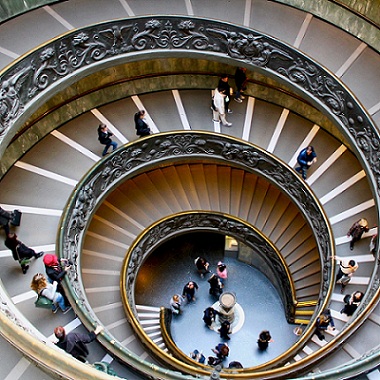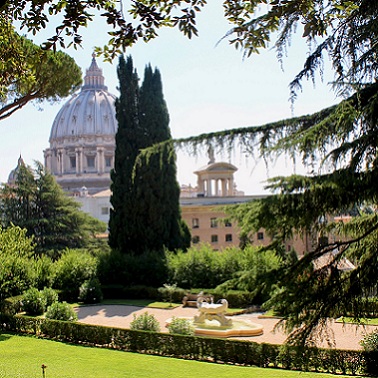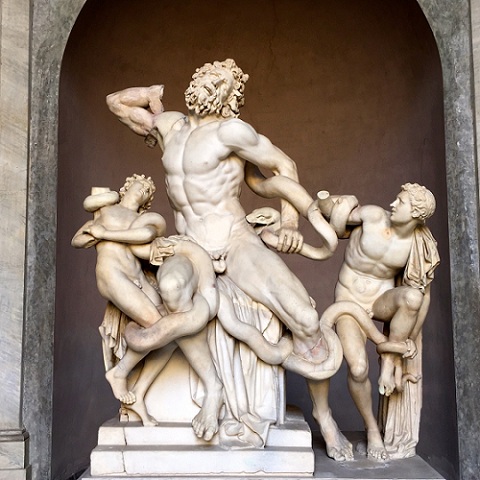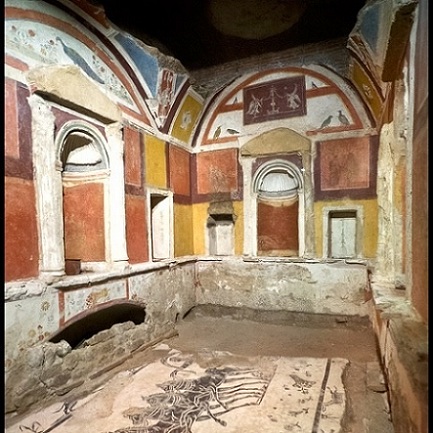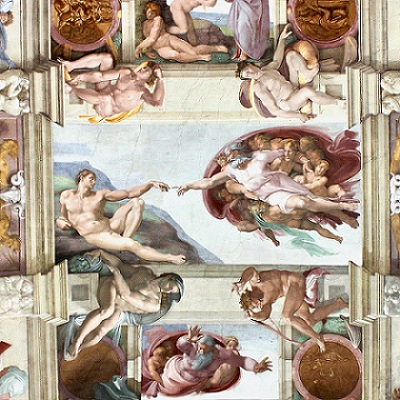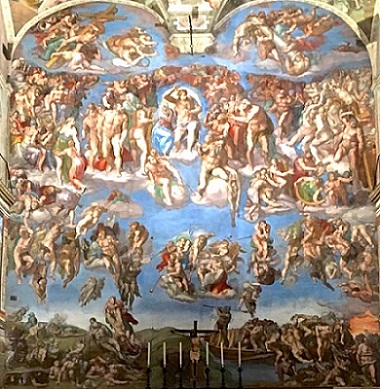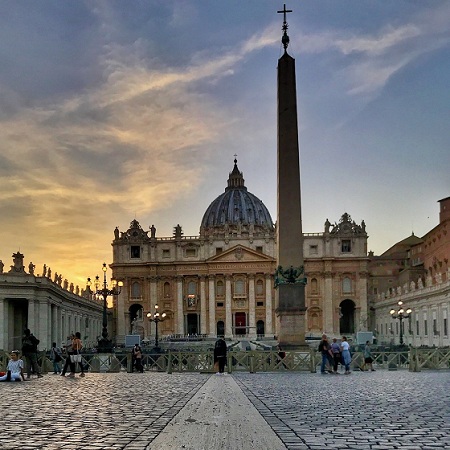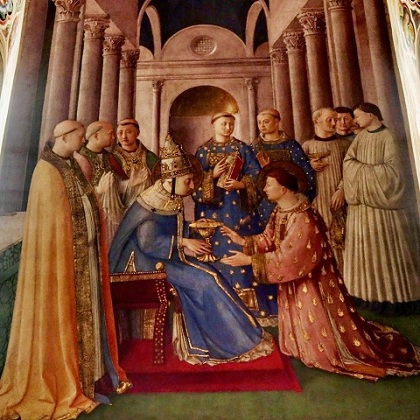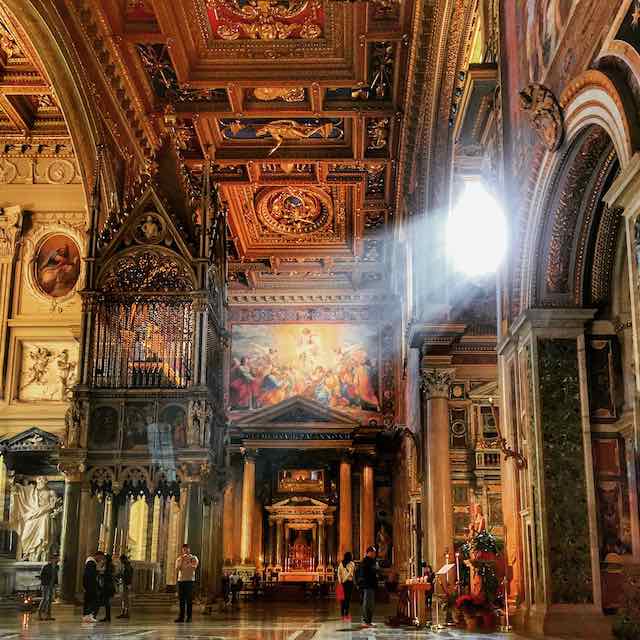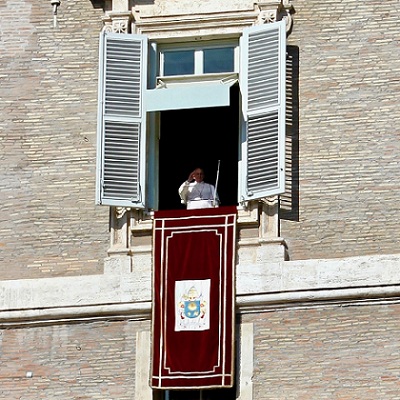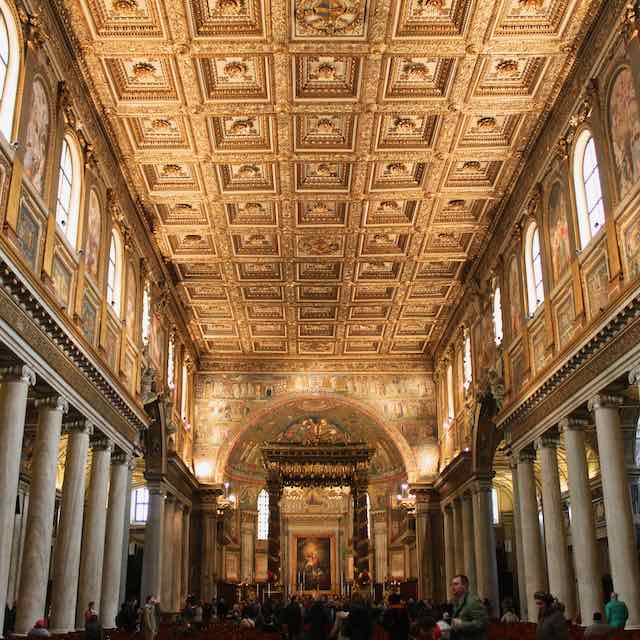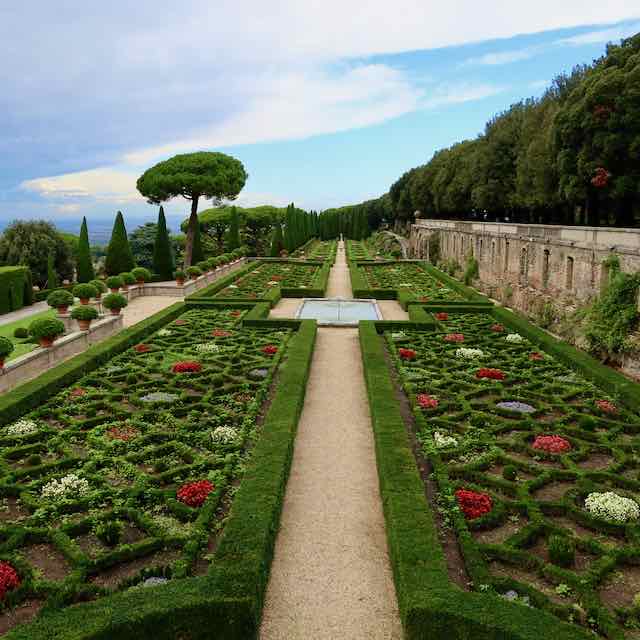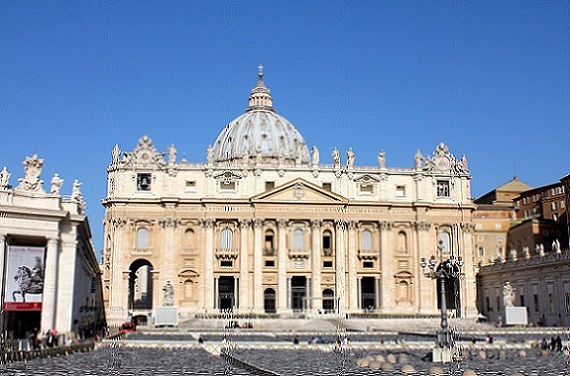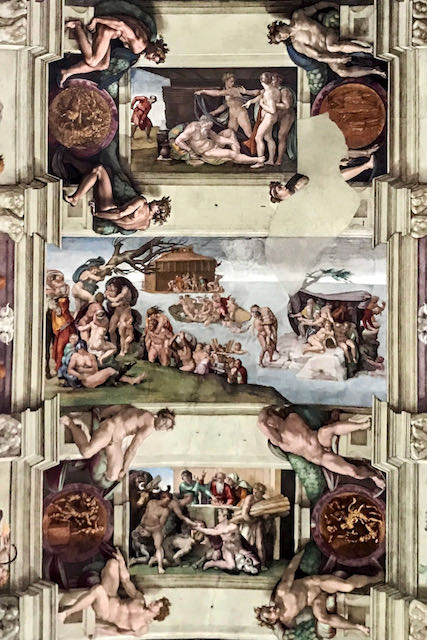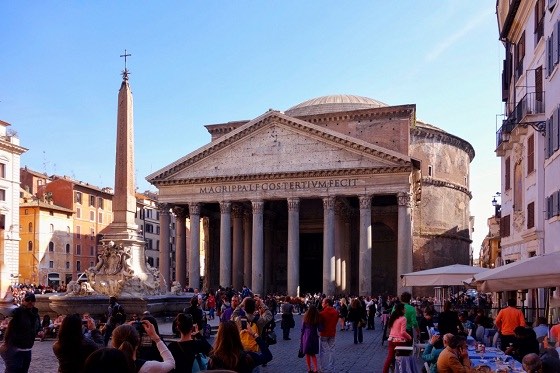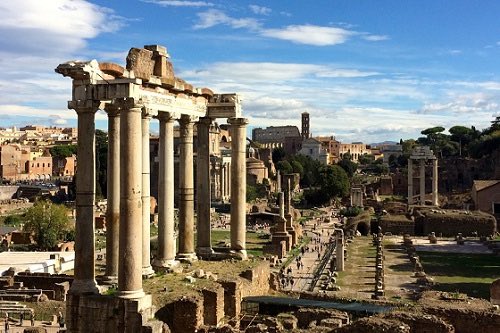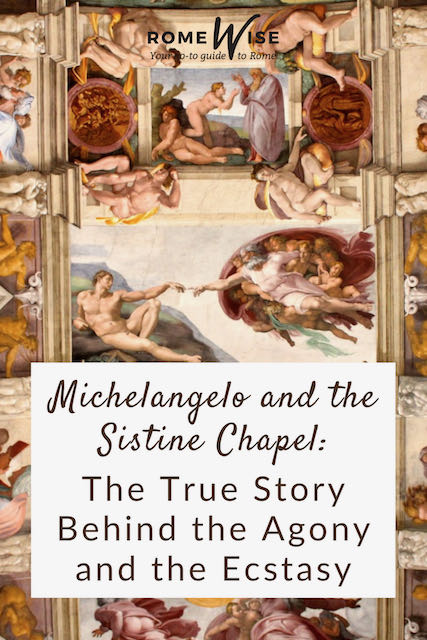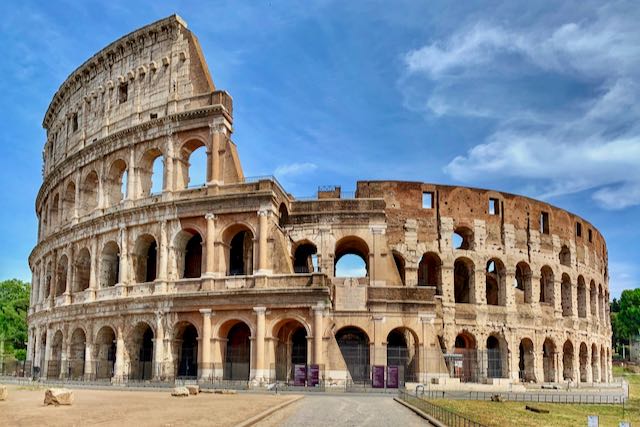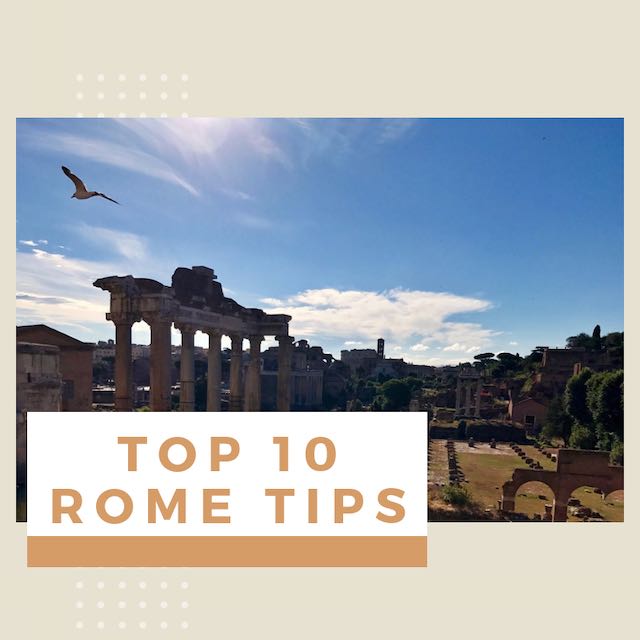- Sign up & get a FREE ebook Subscribe NOW!
- Romewise Home Page
- Visit the Sistine Chapel
- Michelangelo and the Sistine Chapel
Michelangelo And The Sistine Chapel - The Amazing True Story
Michelangelo and the Sistine Chapel.
It's hard to think of one without thinking of the other.
Find out how an unlikely, inexperienced sculptor got the job to paint what would become one of the greatest masterpieces the world has ever seen.
Michelangelo and the Sistine Chapel - a brief history
I was writing a page about the Sistine Chapel, and I realized I needed to dedicate a whole page to Michelangelo and the Sistine Chapel.
Not least because Michelangelo is my favorite artist of all time (I am biased, what can I say?)
As you might imagine, many books have been written on the subject.
Art historians have spent their careers studying this one topic.
There's so much I could tell you about Michelangelo and the Sistine Chapel, but I have created this page to give you some of the basic information to get started.
On this page you'll find out about:
- How, why, and when the Sistine Chapel was built
- Who was Michelangelo?
- Pope Julius II and Michelangelo - tough love
- Michelangelo and the Sistine Chapel - The ceiling paintings
- Michelangelo and the Sistine Chapel - The Last Judgement
- Sistine Chapel virtual tour
To find out more about the best way to visit the Sistine Chapel, visit my page here.
A different kind of page on Romewise
This page about the history of Michelangelo and the Sistine Chapel is a bit different from most pages you will find on this site.
I wanted to give you some of the history, but there is so much to tell, I had to be selective!
You can find a bibliography at the bottom.
This page is for those of you who want a bit of detail about the history, architecture, and paintings of the Sistine Chapel, in particular Michelangelo's work there.
I hope you find this page interesting!
How, when, and why the Sistine Chapel was built
The story of the Sistine Chapel begins before Michelangelo was born, with Pope Nicholas V and Pope Sixtus IV's changes to the Vatican.
Pope Nicholas V and Fra Angelico
In the mid-1400s, Pope Nicholas V decided to make some major changes to the Vatican.
As well as having plans made for the "Old Saint Peter's basilica" to be rebuilt, he also decided that Vatican City was where the Pope should live and had a chapel made for his private use in the Vatican Palace.
Pope Nicholas V had one of the best artists of the day, Fra Angelico, cover the inside of this chapel with frescoes which still exist today.
While this became the Pope's private chapel, there was another papal chapel on Vatican grounds.
It was known as the "Cappella Magna," which means greater chapel.
How to see the Niccoline Chapel inside the Vatican Museums
You can visit the Niccoline Chapel if you take a tour of the Vatican Secret Rooms.
Pope Sixtus IV and his chapel
When the Sistine Chapel was inaugurated in 1483, Michelangelo Buonarroti was only 8 years old.
Francesco della Rovere was elected pope in 1471.
He took the name Sixtus IV.
Pope Sixtus IV was known for many things including rebuilding the Cappella Magna, which had become decrepit.
Between 1473 and 1481, architects worked to rebuild the chapel before it was opened in 1483.
It was thereafter called the Sistine Chapel, named for Pope Sixtus IV.
Sistine Chapel architecture
The exterior is plain, typical of churches of the time.
There's no decorative doorway, since access to it is from inside the Papal Palace.
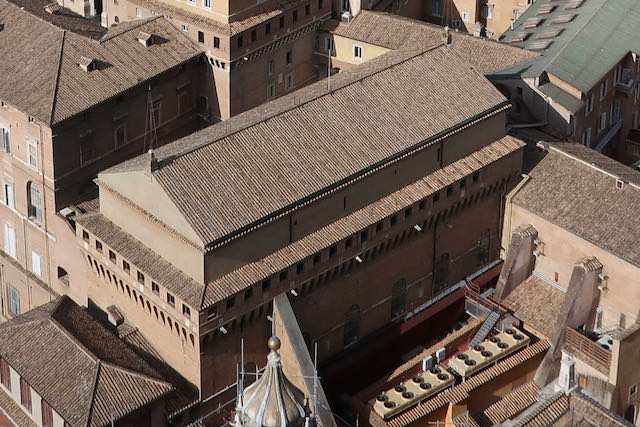 The outside of the Sistine Chapel is austere and fortress-like, as it was intended when it was built in the 15th century.
The outside of the Sistine Chapel is austere and fortress-like, as it was intended when it was built in the 15th century.The architecture of the Sistine Chapel follows the dimensions of Solomon's Temple from the Old Testament, or 6:2:3.
The main chapel space is 134 feet long by 44 feet wide, with a ceiling height of 68 feet.
The ceiling is a barrel vault with windows.
It was meant to also act as a fortress, another architectural feature that was typical of churches of the period.
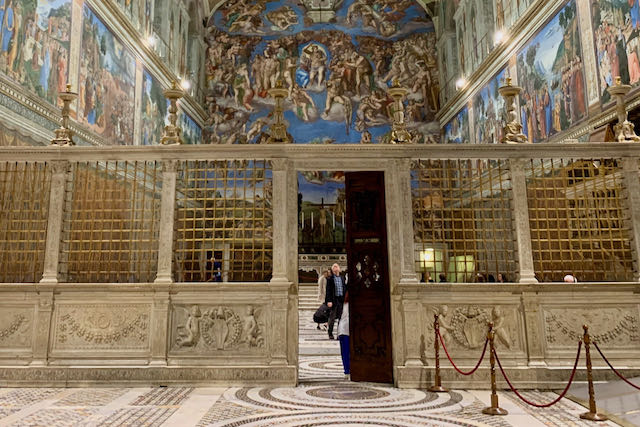 It's easy not to notice this marble screen that stretches across the Sistine Chapel but it's absolutely beautiful and really worth looking at.
It's easy not to notice this marble screen that stretches across the Sistine Chapel but it's absolutely beautiful and really worth looking at.There is a marble screen (transenna) across the middle of the chapel.
It was meant to separate the Pope from the faithful who would stand in the back of the chapel.
Originally it divided the Sistine Chapel exactly in half but over time, as the Pope required more attendants, the screen was moved back to where it stands today.
Who was Michelangelo?
Michelangelo Buonarroti was born March 6, 1475 near Arezzo, about 40 miles outside of Florence.
When he was 13, Michelangelo apprenticed in the workshop of the foremost Florentine artist of the day, Domenico Ghirlandaio.
Even at that age, Michelangelo's raw talent shone through.
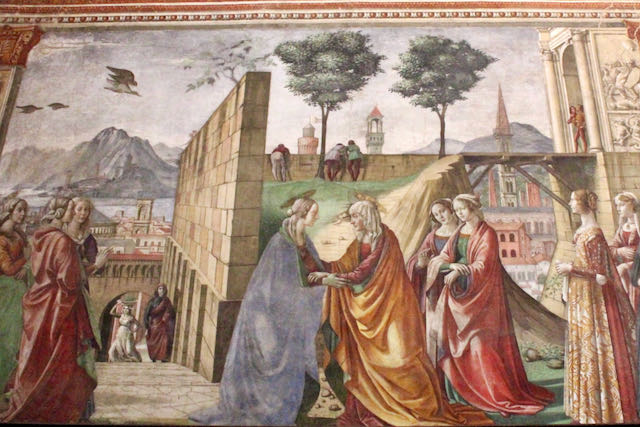 In this painting on the altar of Santa Maria Novella in Florence, Domenico Ghirlandaio allowed Michelangelo to paint the three figures in the background, with their backs to us.
In this painting on the altar of Santa Maria Novella in Florence, Domenico Ghirlandaio allowed Michelangelo to paint the three figures in the background, with their backs to us.Lorenzo de Medici was a great lover of the arts.
He had the best creators live on his property as a sort of artists' colony, giving them room and board, materials, and the time and space to create.
Michelangelo spent some of his formative years here.
This is where his love for sculpting and his innate talent began to really shine through.
He became so passionate about wanting to sculpt the human body correctly that he paid an attendant at the city morgue to sneak in at night and cut open the bodies of unclaimed corpses.
This was illegal and punishable by death, but Michelangelo was determined.
Without having seen the Sistine Chapel, one can form no appreciable idea of what one man is capable of achieving.— Johann Wolfgang Goethe, 23 August 1787
Michelangelo began getting larger and larger commissions, before he got a commission to come to Rome and sculpt something for a side chapel in Old Saint Peter's Basilica when in his early twenties.
By the time Michelangelo finished his masterpiece, the Pietà, his patron had died.
Not only that, but the basilica where it was to go was leaning heavily, and Michelangelo was afraid to put his work in there for fear it would be crushed when the building collapsed.
Nonetheless, he and some friends snuck it in, where Pope Julius II would see it.
No matter what season you visit Rome, here are 4 essential things we recommend never leaving home without:
Disclosure: If you make a purchase through a link on this page, I may receive a small commission - at no extra cost to you. Thank you for supporting my site!
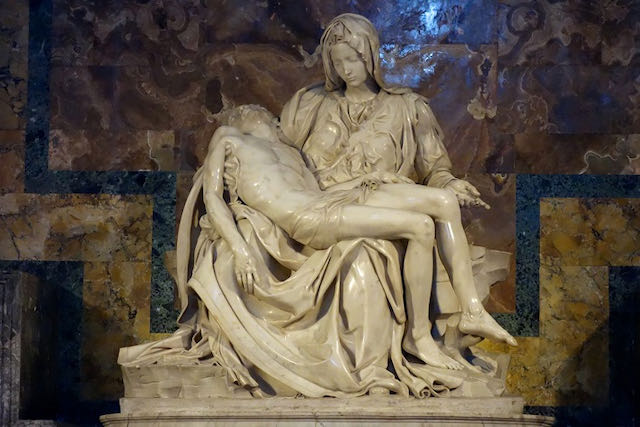 Michelangelo and the Sistine Chapel - there is more of his work around the Vatican and Rome, like his stunning Pietà in Saint Peter's Basilica.
Michelangelo and the Sistine Chapel - there is more of his work around the Vatican and Rome, like his stunning Pietà in Saint Peter's Basilica.Pope Julius II and Michelangelo - tough love
Pope Julius II was the nephew of Pope Sixtus IV, and was a man to be reckoned with.
He was nicknamed "the warrior pope" because he actually went to battle defending Rome and the papacy.
Pope Julius II decided Michelangelo should build his tomb.
And it was to be monumental, literally.
It was going to be so grandiose that both the Pope and Michelangelo agreed that Saint Peter's Basilica needed to be rebuilt to house it.
how Pope Julius II harangued a sculptor and convinced him to paint
Pope Julius II had a lot of projects at the Vatican.
He was collecting antiquities that were being unearthed around Rome.
These included the Laocoön sculpture, the Belvedere torso, and the Belvedere Apollo.
Michelangelo was heavily influenced by this ancient Greco–Roman art.
Pope Julius began the collection that would become the Vatican Museums as well as revisiting the idea of rebuilding Saint Peter's Basilica.
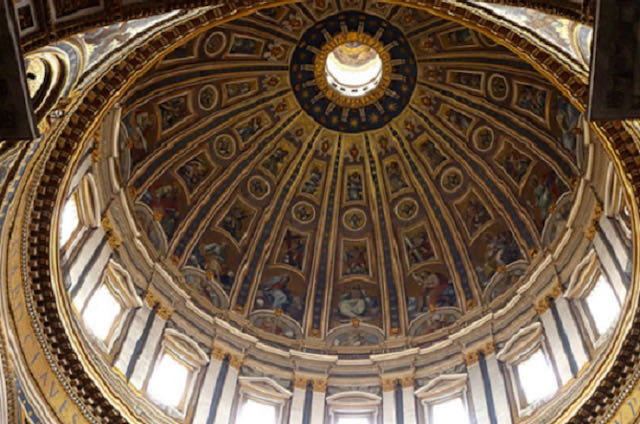 Michelangelo had a hand in much of what you see today at the Vatican, including the design of the dome.
Michelangelo had a hand in much of what you see today at the Vatican, including the design of the dome.The first chief architect for the basilica that Pope Julius consulted was Donato Bramante, who was not thrilled about a young upstart getting such a big commission from the Pope for the tomb project.
Bramante thought he might try to nip this in the bud by suggesting that the Pope have Michelangelo paint the Sistine Chapel's ceiling, yet another of the Pope's many projects.
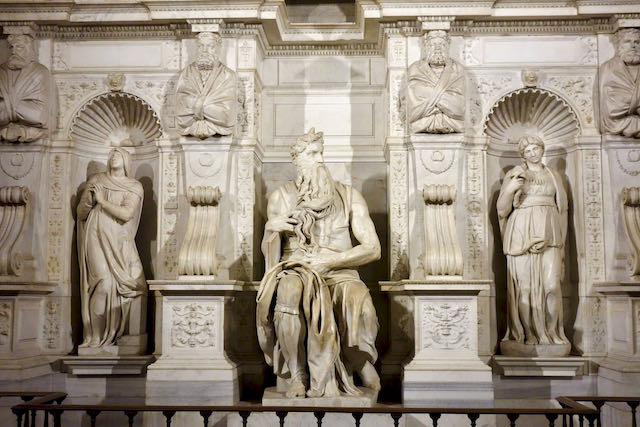 Michelangelo's Moses for the (unfinished) tomb of Pope Julius II is yet another of his masterpieces. You can it see in the Catholic church of San Pietro in Vincoli near the Colosseum in Rome.
Michelangelo's Moses for the (unfinished) tomb of Pope Julius II is yet another of his masterpieces. You can it see in the Catholic church of San Pietro in Vincoli near the Colosseum in Rome.Pope Julius II commissioned Michelangelo to paint the chapel, but he refused on the basis that he was a sculptor and wanted only to sculpt, not paint.
Michelangelo was also in the middle of sculpting the pope's tomb, and he didn't like to interrupt his work, once begun.
There was quite a bit of back and forth but in the end, you know who won that argument.
The Pope wanted Michelangelo to paint the 12 apostles.
Michelangelo said, let's think big, really big.
Let's think Genesis!
The first book of the Bible.
And you know who won that argument too.
Painting the ceiling of the Sistine Chapel
how the project began
Michelangelo had honed his drawing skills in Ghirlandaio's workshop.
He had also learned a little bit about fresco painting by assisting more experienced fresco artists.
But he still saw himself primarily as a sculptor, and that is the work he loved most.
He never wanted to paint.
So, when Michelangelo finally accepted the job to paint the Sistine Chapel ceiling, he brought a few trusted artists from his native Florence to work with him, partly to help him get started with this technique.
the scaffolding
Obviously, Michelangelo would need some sort of scaffolding.
Bramante and his assistants built scaffolding to Michelangelo's specifications.
It was a flat, wooden platform that came out from the side walls high up near the tops of the windows.
Contrary to the romantic idea of Michelangelo lying on his back to paint the Sistine Chapel, Michelangelo actually stood on his scaffolding while he painted.
Think about doing this for four years.
It caused Michelangelo tremendous neck and back strain, and damaged his eyesight irrevocably.
Ceiling Elements
Michelangelo had a daunting task ahead of him.
How to fill a 6,000 square feet expanse?
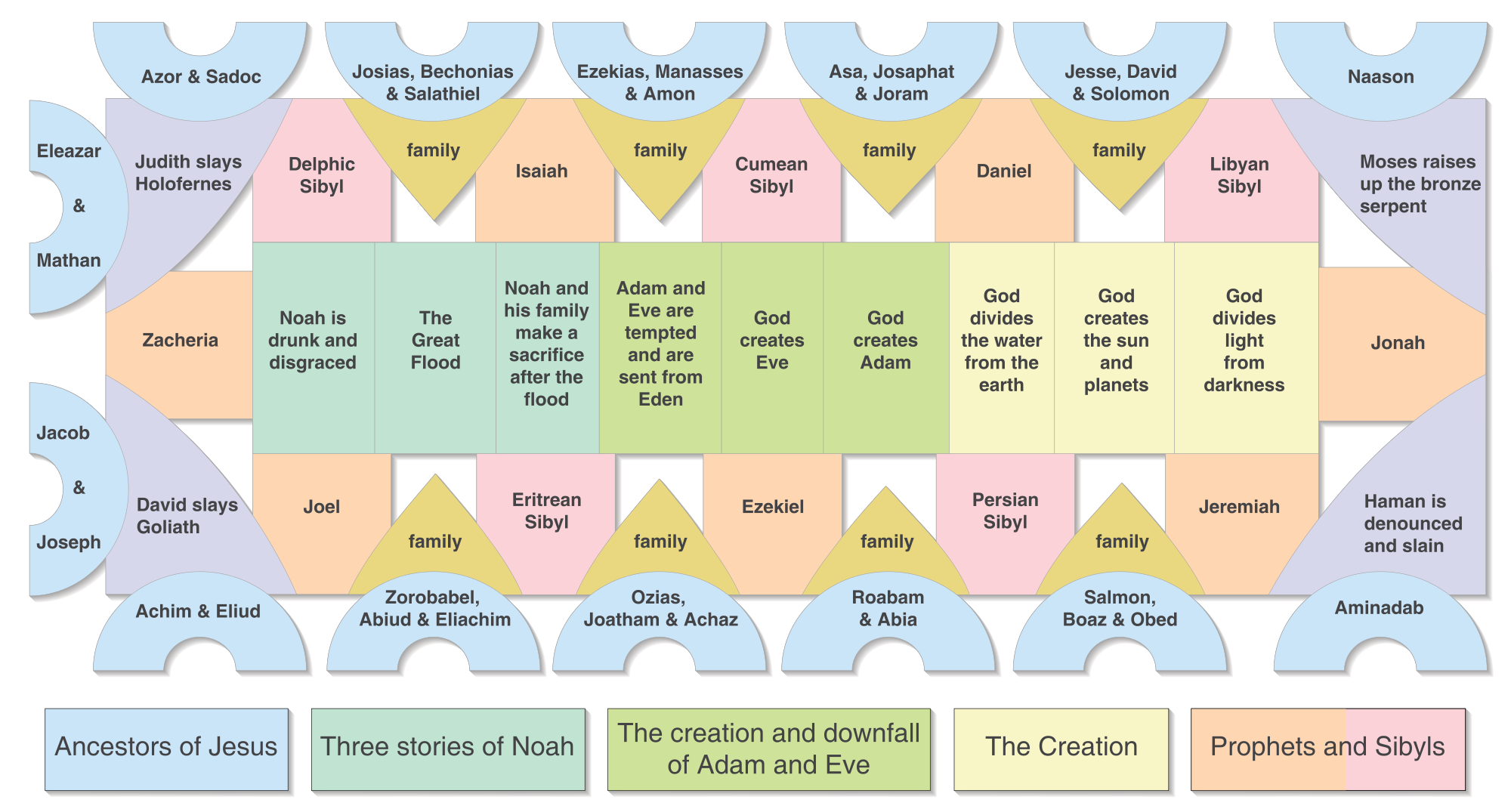 Diagram of the Sistine Chapel ceiling. TTaylor work adapted by Begoon - on Wikimedia Commons
Diagram of the Sistine Chapel ceiling. TTaylor work adapted by Begoon - on Wikimedia CommonsCertainly the most admired section of the ceiling today is the vault in the center with its nine panels from the Old Testament.
The panels are divided into three sections, each with three paintings.
They represent:
- The Creation of the Heavens and Earth
- The Creation of Adam and Eve (Humankind)
- Noah and the Great Flood
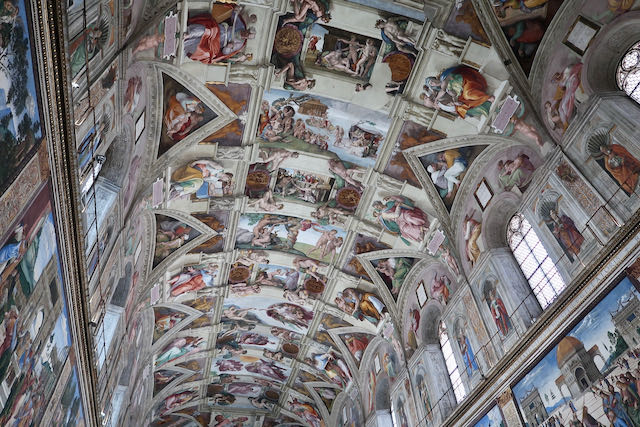 Michelangelo and the Sistine Chapel - the most famous part of all the Old Testament scenes is the nine-panel section depicting Genesis in the center vault.
Michelangelo and the Sistine Chapel - the most famous part of all the Old Testament scenes is the nine-panel section depicting Genesis in the center vault.Noah and the flood
Michelangelo began by painting the stories of Noah and the Flood.
These panels were farthest from the altar where the Pope would stand, and he wanted to start here so that he could improve his technique as he moved closer to the altar, as well as giving him time to decide how to paint God.
If you enter the Sistine Chapel from the back, the first panel is of the Drunkenness of Noah.
This is followed by the Great Flood and then the Sacrifice of Noah.
These panels are actually out of order, but it may be that Michelangelo needed the large middle panel to depict more scenes of the flood.
On that panel alone, he painted over 60 figures, depicting the tragedy about to befall them.
Adam and Eve
In 1510, Michelangelo took a year off from painting the Sistine Chapel.
The Pope was impatient and forced Michelangelo to unveil what he'd already done.
The crowds were awed.
But Michelangelo had yet to paint what would become his masterpiece - God's creation of humankind.
When Michelangelo began to paint the scenes depicting Adam and Eve, he had a much better handle on fresco work, and he understood the kind of image he needed to portray to make an impact on viewers below.
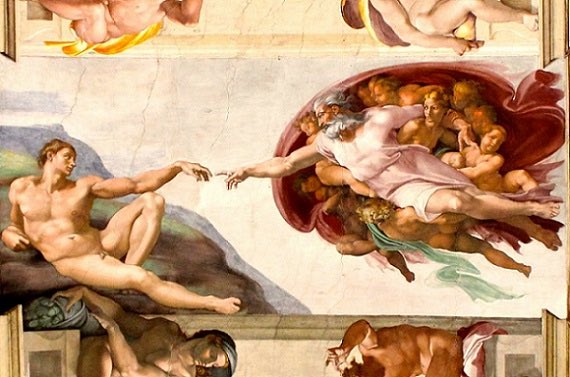 Michelangelo and the Sistine Chapel - Creation of Adam 1508–1512.
Michelangelo and the Sistine Chapel - Creation of Adam 1508–1512.He had also had plenty of time to decide how he would portray God.
In these panels, God is portrayed as a grey-bearded rugged old man.
Nobody had ever depicted God this way before.
But since then, it has become normal to see this in religious paintings.
Michelangelo changed everything.
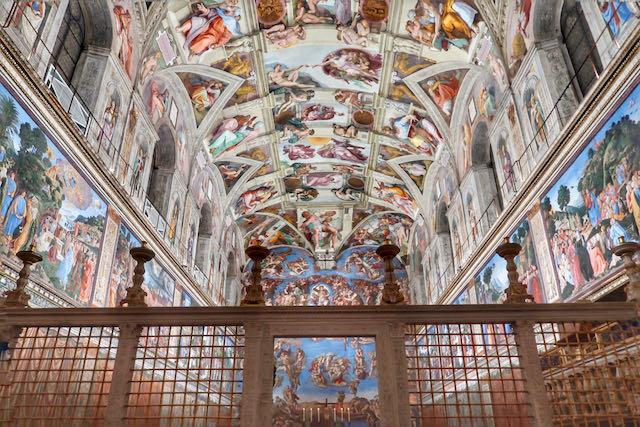 Michelangelo and the Sistine Chapel - his ceiling depicts scenes from Genesis, while his Last Judgement on the back wall is about the Apocalypse.
Michelangelo and the Sistine Chapel - his ceiling depicts scenes from Genesis, while his Last Judgement on the back wall is about the Apocalypse.God creates the universe
The last three panels are from the beginning of Genesis, showing God creating the universe.
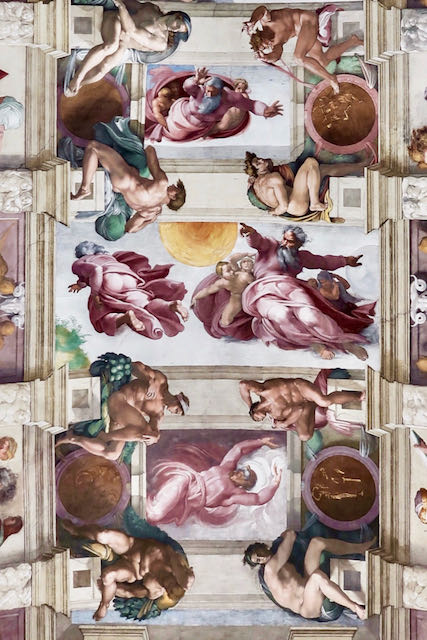 Michelangelo and the Sistine Chapel - These three panels are from Genesis and depict God creating the universe.
Michelangelo and the Sistine Chapel - These three panels are from Genesis and depict God creating the universe.On the first panel, God creates light, separating it from darkness.
The middle panel shows God creating the sun, moon and plants.
The third panel shows God dividing the waters from the heavens.
Michelangelo finished the Sistine Chapel ceiling in October 1512, wowing everyone when it was unveiled.
Michelangelo and the Sistine Chapel - The Last Judgement
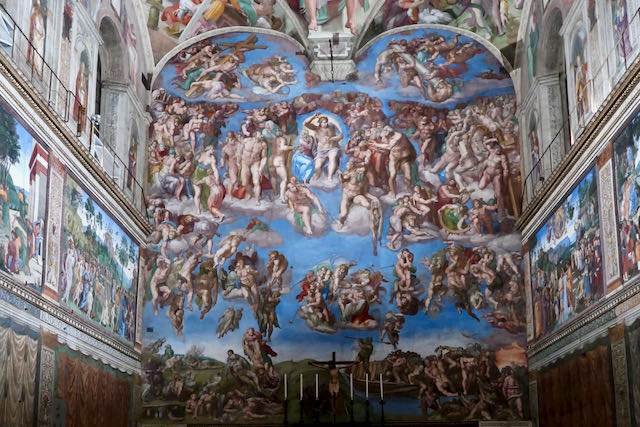 The Last Judgment.
The genius of Michelangelo fatefully immortalizes the moment in which the angels announce the unleashing of the Apocalypse, with a blast of trumpets.
The Last Judgment.
The genius of Michelangelo fatefully immortalizes the moment in which the angels announce the unleashing of the Apocalypse, with a blast of trumpets.What happened next
In September 1534, only days before his death, Pope Clement VII commissioned Michelangelo to paint the back wall behind the altar of the Sistine Chapel.
Preparations for the wall began in 1535, and Michelangelo painted the wall under the jurisdiction of Pope Paul III (Farnese), between 1536 and 1541.
Times had changed.
In the years after Michelangelo's frescoes on the ceiling were finished, much had happened in Rome, Italy, and Europe and Michelangelo's outlook on life had grown darker.
This was reflected in the painting he created, the Last Judgement.
the meaning of the Last JudgEment
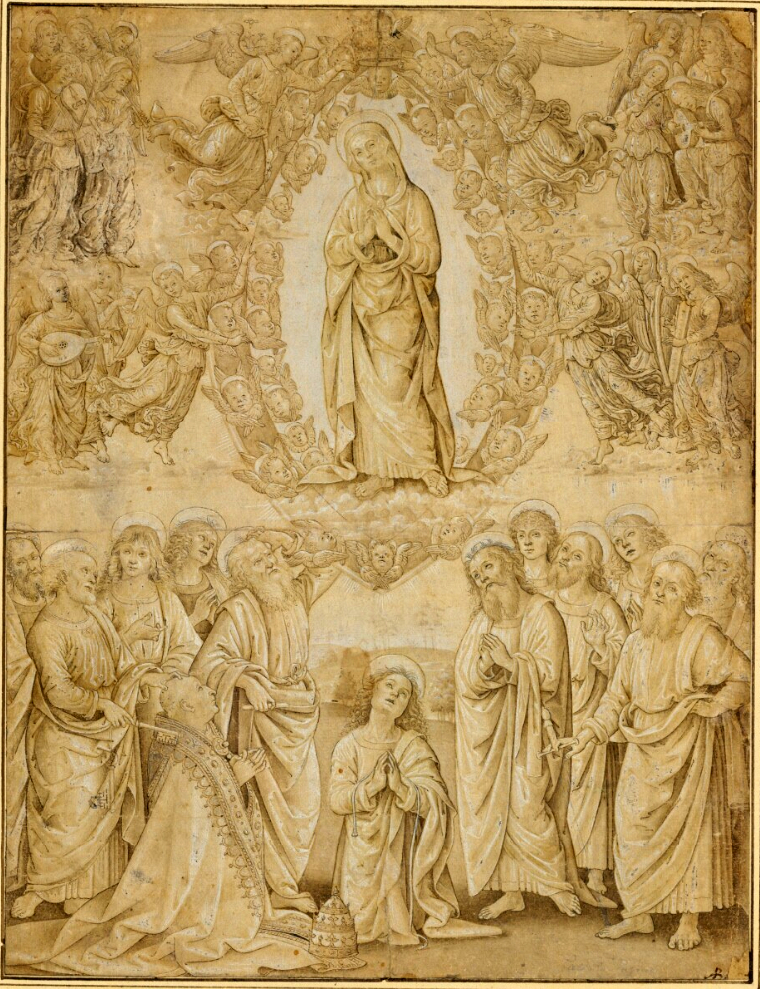 The original painting on the altar wall of the Sistine Chapel was the Assumption of the Virgin Mary by Perugino. Only this sketch survives.
The original painting on the altar wall of the Sistine Chapel was the Assumption of the Virgin Mary by Perugino. Only this sketch survives.The entire wall behind the altar of the Sistine Chapel is covered with Michelangelo's Last Judgment.
The Last Judgment shows the second coming of Christ and the final judgment of those doomed to hell or being sent to heaven.
The painting shows Christ in the middle, with his mother Mary next to him, surrounded by the 12 apostles.
Altogether there are over 300 figures, with nearly all the males and angels originally shown as nudes.
The painting shows souls saved and rising toward heaven on the left.
On the right, you can see souls that are damned and are being pulled down towards hell.
To the right of Christ, you can see St. Bartholomew with his flayed skin.
Most scholars agree that the face in the skin is that of Michelangelo, a self portrait.
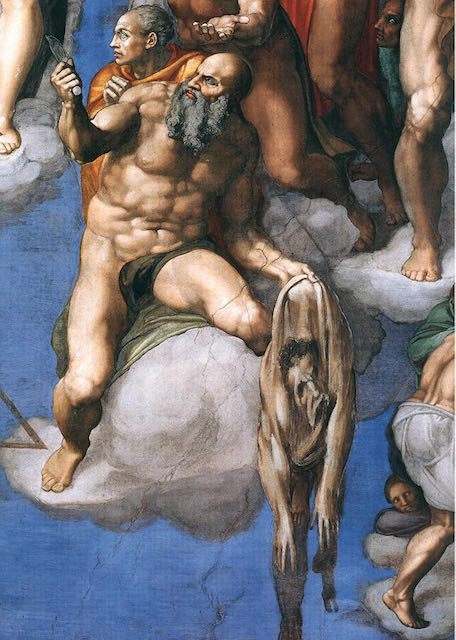 In the Last Judgment,
San Bartolomeo has a place of honor and has always been one of the most emblematic figures in the fresco.
According to some scholars, the flayed skin he holds in his hand could very well be a self-portrait of Michelangelo
In the Last Judgment,
San Bartolomeo has a place of honor and has always been one of the most emblematic figures in the fresco.
According to some scholars, the flayed skin he holds in his hand could very well be a self-portrait of MichelangeloSome speculate this was a reflection of Michelangelo's anguish at being forced to paint yet again.
Other theories suggest Michelangelo was trying to redeem himself for things he had done when he was younger.
He had become more devout with age, and maybe he was worried about the fate of his soul.
Ready to plan your trip?
Book your train
Planning to travel between cities in Italy and other parts of Europe?
Use Trainline to see all the different options available across the different rail companies.
Find your hotel
Find your perfect place to stay in Rome.
Use Booking.com to choose between hotels, guesthouses, and self-catering apartments in neighborhoods throughout the Eternal City.
Buy your TurboPass
Purchase the convenient Turbopass and visit all of Rome's top attractions including the Colosseum, Pantheon, and Vatican.
With one handy pass, it's all included.
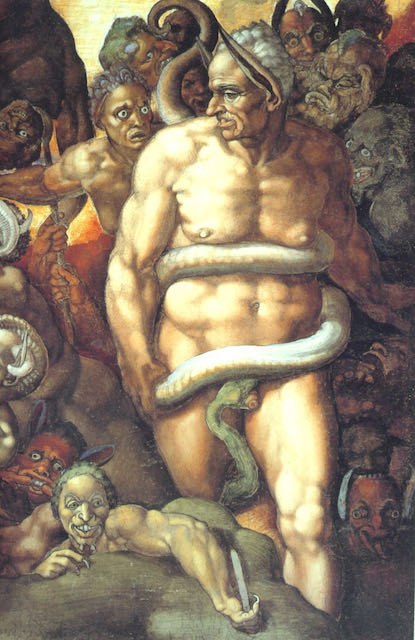 Minos. The feared judge of darkness. Another mythological figure painted by Michelangelo
Minos. The feared judge of darkness. Another mythological figure painted by MichelangeloSatan himself is not depicted, but at the bottom right we see Minos, supervising the admission of the damned into Hell.
When the Last Judgement was complete, Pope Paul III supposedly fell to his knees before it and prayed.
Others were not so favorably impressed, with nudity in religious Renaissance art being frowned upon.
One very vocal critic was Biagio da Cesena, Papal Master of Ceremonies.
In response to his criticism, Michelangelo went back and worked Cesena's face into the figure of Minos, giving him donkey ears and a snake biting his genitals.
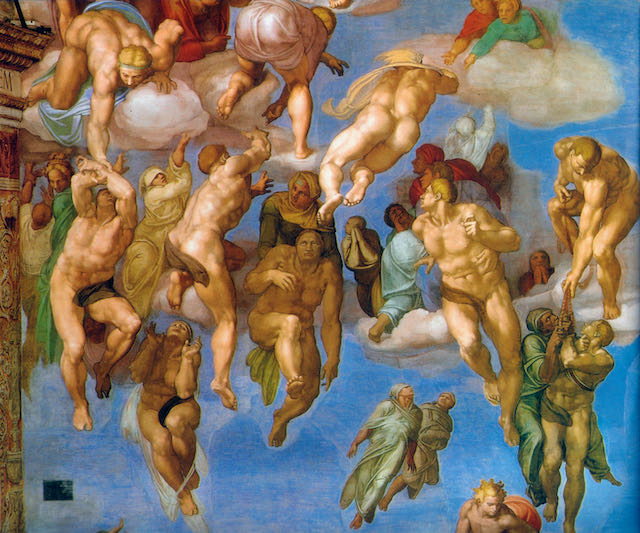 Michelangelo painted everyone nude because that is how he imagined they would meet the end of days. Humans are born naked and in the end they die naked.
Michelangelo painted everyone nude because that is how he imagined they would meet the end of days. Humans are born naked and in the end they die naked.Another critic was Cardinal Carafa who said that the painting was obscene and insisted that the genitals be covered.
Michelangelo refused, but in 1562 the Council of Trent issued a decree regulating the use of images in churches.
Now the nudity had to be covered.
Michelangelo's pupil and friend Daniel da Volterra did it on his behalf, promising his friend he would disturb his original painting as little as possible.
This did little to placate Michelangelo.
Over time, more and more of the nudity was covered.
During the most recent restoration many of these black cloths were removed, but not the ones originally painted by da Volterra.
The cloths left in place remind us that without them, the painting might have been destroyed entirely.
Michelangelo died on February 18, 1564, days shy of his 89th birthday.
How lucky are we that he lived so long and was able to give the world so much?
Michelangelo and the Sistine Chapel - a virtual tour
Click here to take a virtual tour of Michelangelo's masterpiece.
Want to see it in person?
Find out how to get Vatican Museums tickets here.
Michelangelo and the Sistine Chapel - bibliography
I hope you have enjoyed this page about Michelangelo and the Sistine Chapel! These are the resources I used most:
- Ross King, Michelangelo and the Pope's Ceiling
- Irving Stone, The Agony and the Ecstasy
- Giorgio Vasari, The Lives of the Artists
- Claudia Viggiani, Rome through My Eyes
- Antonio Forcellino, Michelangelo - A Tormented Life
- Reliable online resources including Wikipedia, National Geographic, The Khan Academy, Vatican Museums
Romewise's Top Travel Resources
Ready to book your trip to Rome? Take a look at these helpful links to companies we use and trust:
- Keep your travel spending simple with the Wise card, which removes all the worry about exchange rates and high transaction fees all over the world
- Search for and book your perfect accommodation
- Our complete guide to what to pack for Rome
- The number one travel accessory, a multi-point travel adapter and voltage converter
- Browse a huge range of tours in Rome and beyond
- Experience unique tours and special access to Rome's most popular sights
- Protect yourself with comprehensive travel insurance
Within this post there are some affiliate links for products and services. For more details about our affiliate policy click here.
Get your 100% free Rome trip planner now!
Simply sign-up today for our free newsletter and get the Romewise Quick Start guide to Rome:
We are committed to respecting your data. Click for our Privacy Policy.
Comments? Questions? Suggestions?
Please come over to the private Romewise Facebook group and join in the conversation.
You will often find me there, happy to answer your questions / comments!
You will also meet other Rome lovers and experts, too.
What are you waiting for?
- Romewise Home Page
- Visit the Sistine Chapel
- Michelangelo and the Sistine Chapel

